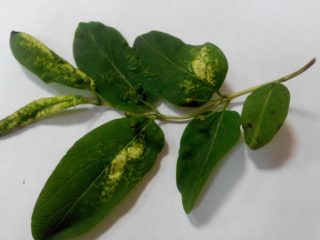Content
More recently, honeysuckle has been cultivated on personal plots. There are many varieties of it. To get berries, it is better to choose varieties of self-fertile honeysuckle. They are well pollinated, the harvest ripens rich.
Does honeysuckle need a pollinator
Honeysuckle inflorescences are bisexual, require cross-pollination. Insects carry pollen. It is important that different varieties of this culture are pollinated among themselves. This will increase the yield and taste of the berries.

For a garden, it is better to purchase not 2, but 4 shrubs with different varietal characteristics
Each of them has its own, the best pollinator. The greater the variety of honeysuckle species in the garden, the higher the yield of blue berries.
How honeysuckle is pollinated
Not all types of fruit crops are self-fertile. Several pollinating shrubs are planted to obtain the harvest. During the growing season, bisexual paired flowers ripen in them. Each of them is dismissed for 1 day. An insect can pollinate even 1 flower, but the fruits will ripen in pairs.
Honeysuckle is a cross-pollinated crop. Pollen of flowers is carried by insects, wind, birds. For a shrub, 2-3 varietal pollinators are needed. In the garden, they are planted at a short distance from each other.
At what distance is honeysuckle pollinated
This culture is growing slowly. An adult shrub can reach impressive sizes. When planting, the distance between the seedlings is made at least 2.5 m. This will allow the tree to grow in the future, there will be no problems with pollination of neighboring bushes.
With a closer planting, different types of this culture merge into one bush. In this case, pollination is difficult. The harvest of berries can not be expected at all.
How to find a pollinator for honeysuckle
Before buying seedlings, study the characteristics of each of them. A young tree should have a good yield, bloom at the same time as a partner, and correspond to the climatic conditions of the region. In the description of the seedling, breeders indicate which varieties of self-fertile honeysuckle are best combined.
How many honeysuckle bushes need to be planted for pollination
The described culture is an expensive plant that cannot be propagated independently by layering or cuttings. Gardeners have to buy shrubs. In order to save money, a couple of bushes are planted nearby. Ideally, there should be 4. So the honeysuckle is pollinated in the best way, gives a high yield.
Self-pollinating varieties of honeysuckle
In order for different varieties of honeysuckle to mix (dust), it is important to choose them correctly. They are planted in pairs, not far from each other.
Self-fertile variety Nymph
The shrub is appreciated for the high taste of the fruit. It is also highly frost-resistant. Shoots can withstand temperatures as low as -50 ᵒС. The crop is intended for cultivation in regions with long and cold winters.
The fruits of this honeysuckle are edible, but the shrub requires pollinators to produce ovaries. The variety is classified as a medium-ripening crop. The height of the shrub does not exceed 2.5 m. The leaves are elongated, oval, dark green.

Berries are oblong, fusiform, uneven, lumpy
The weight of one fruit does not exceed 0.9 g. The berries are sweet and aromatic, the tasting score is 4.7 points out of 5 possible.
Self-fertile variety Amphora
This is a low-growing plant, the height of which is approximately 1.5 m. The crown is compact, round. The decorative qualities of this shrub allow it to be used as a hedge or garden decoration.
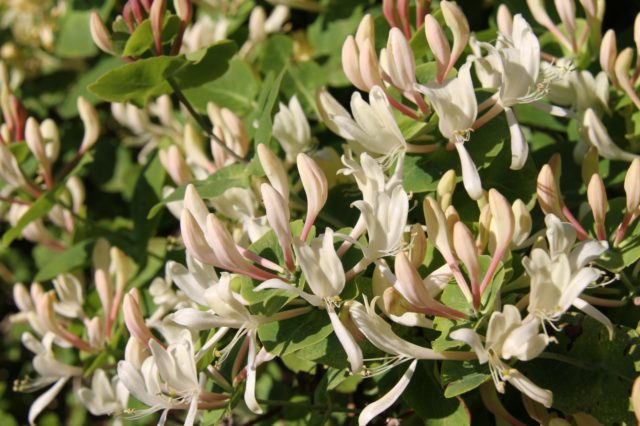
The flowering of this decorative and fruit crop is abundant, the petals are narrow, at first pale pink, later pure white
The fruits of the Amphora variety are large, up to 2 cm in length, their weight can reach 3 g. Their shape is elongated, the surface is smooth, the color is bluish-blue with a slight smoky bloom. The taste is sweet and sour, with a slight bitterness, tasting score - 4.5 points.
Self-fertile variety Blue bird
It is an early crop that can be cultivated even in areas that are classified as risky farming areas. This is a medium-sized self-fertile variety that was bred in the last century.
The height of the shrub reaches 2 m, the crown is wide, spreading, thickened, takes the form of a ball or ellipse.
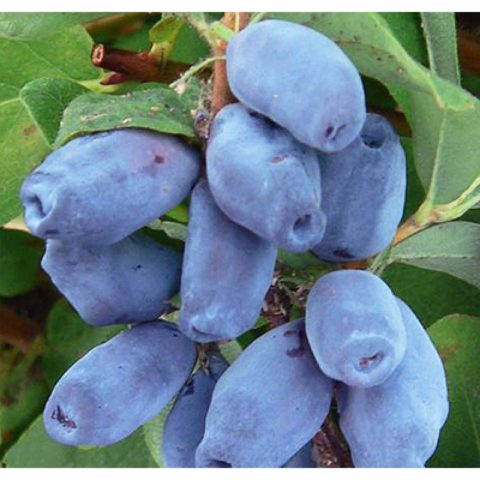
The length of the berries does not exceed 2 cm, and the weight is 1 g, they are oblong, thickened, resemble a barrel in shape
The skin of the berries is thin, delicate, dark blue, almost black, covered with a bluish bloom, which is easily erased. The taste and aroma of the fruit is sweet and sour, reminiscent of blueberries. Tasting score - 4.5 points.
The best pollinators of honeysuckle
Every self-fertile varietal plant requires the same pollinator. Some of them are versatile and work well for almost all types of honeysuckle.
Self-fertile Blue Spindle
This culture is used as a pollinator for all types of honeysuckle. This is a versatile, unpretentious variety that is planted only in conjunction with others.
Self-fertile shrub does not grow more than 1.5 m, has a rounded and compact crown. Under the influence of the sun, its shoots turn dark red or purple.
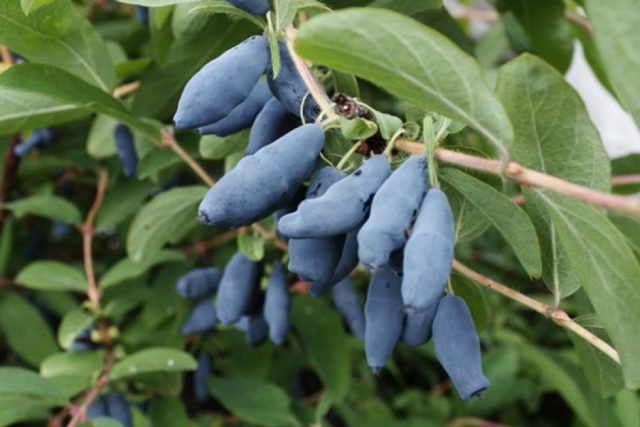
The shape of the berries resembles a spindle: it expands towards the center and tapers at the edges.
The surface of the fruit is uneven, lumpy. The length of the berry can be up to 2.7 cm, weight - up to 1 g. The color is light blue, there is a bluish bloom. The taste of the fruit is sweet and sour, but due to the bitter aftertaste, its tasting score is only 3.7 points.
This self-fertile culture is used as a pollinator for other dessert varieties: Blue Bird, Amphora, Nymph. The fruits are practically not consumed fresh, they are processed into compotes and jams.
Self-fertile variety Kamchadalka
This is a low-growing shrub, the height of which does not exceed 1.5 m. The crown is compact, dense, narrowed, inversely conical in shape.
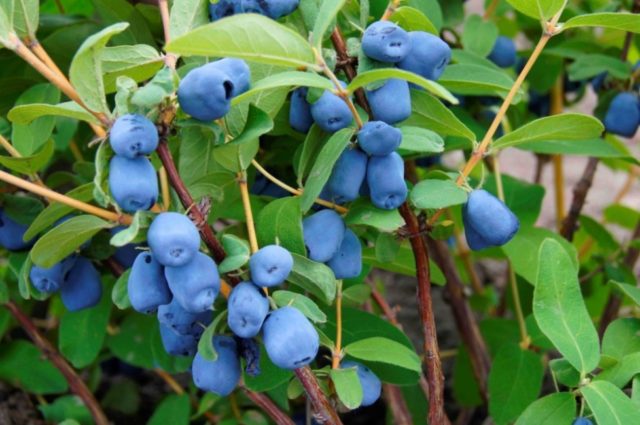
The leaves of self-fertile Kamchadalka are oval, oblong, pale green, the shrub is not densely covered with them
The berries are medium in size, their length does not exceed 2 cm, and their weight is 1 g. The shape is elongated, oval, the tip is pointed.
The pulp of the fruit has a sweet and sour taste, but it is fibrous in consistency. Taste is rated at 3.8 points.
This self-fertile culture is suitable for pollination of such representatives of the species: Berel, Cinderella, Blue Spindle.
Self-fertile variety Berel
The height of the shrub exceeds 2 m. The crown is spreading, the shoots are large, strong, straight. Leaves are oblong, oval, their lower part is slightly pubescent. The variety is classified as early maturing.

The berries are pear-shaped or conical in shape, their color is bluish-black with a purple tint
The surface is uneven, bumpy. A whitish bloom almost never appears. During the season, up to 4 kg of fruit can be harvested from one self-fertile shrub. Their taste is sweet and sour, and bitterness is also present. Tasting score - 4.1 points.
Self-fertile variety Cinderella
This honeysuckle is not very productive, but its berries are sweet and have a pleasant strawberry flavor.
The self-fertile variety Cinderella is a low-growing shrub, the height of which is only 0.8 m, while the crown is spreading and dense. Shoots are thin, curved, slightly pubescent.
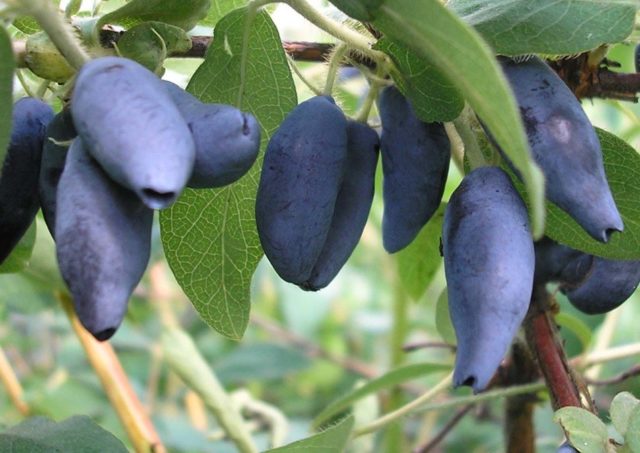
The berries are large, their weight can be up to 1.5 g, and the length is up to 2 cm, the shape is elongated, fusiform
The skin of the fruit is thin, delicate, dark blue or purple in color. There is a bluish bloom on the surface.
The taste of the berries is good: sweet, with a slight bitterness, which is practically not felt. The tasting score depends on the climatic conditions in which the shrub is cultivated, it ranges from 4.8 to 5 points.
Cinderella suits all of the above varieties of honeysuckle that pollinate each other.
Conclusion
Almost all varieties of self-fertile honeysuckle are suitable for pollinating each other. You can choose a couple of fruitful shrubs with high taste qualities of berries. In addition to them, a compact honeysuckle tree is planted, which is suitable for pollination of each representative of the species. The Blue Spindle is considered such a versatile variety.





